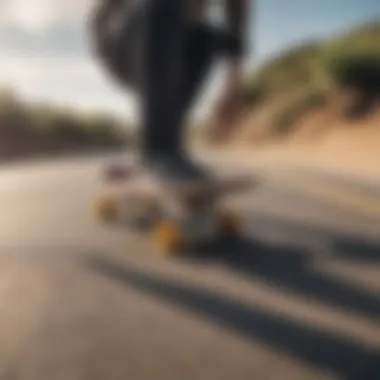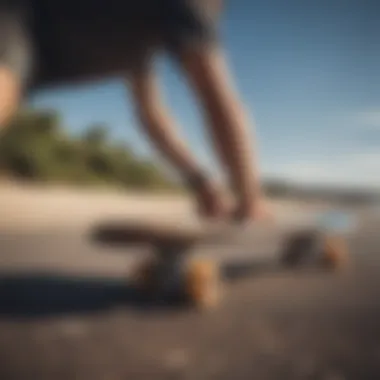Beginner's Guide to Choosing the Right Skateboard


Intro
Skateboarding is not just a sport; it’s a lifestyle, a form of expression, and a thrilling way to navigate the urban landscape. For many making that initial plunge into this exciting world, selecting the right beginner skateboard can feel like looking for a needle in a haystack. The options are abundant, and all sorts of different factors must be considered. From understanding what features matter most to knowing how to maintain your board once you have it, this guide aims to simplify the process.
As a beginner, it’s essential to grasp the various types of skateboards available. Each type serves a unique purpose and caters to different aspirations. With the right knowledge, your first choice can lead to a fun and fulfilling journey on your skateboard. Throughout this guide, we’ll delve into the main elements to consider, ultimately empowering you to make an informed decision that suits your requirements.
Understanding the terms and components associated with skateboarding opens the door to not only bigger adventures but also a deeper appreciation for the sport itself. So, let's kick things off with an exploration of skate gear and equipment that every novice should know.
Understanding Skateboarding
Understanding skateboarding is crucial for anyone looking to embark on this thrilling journey. This section sets the stage for grasping the fundamental aspects of skateboarding, which includes its definition, evolution, and cultural relevance. By digesting this information, beginners can navigate the world of skateboarding with confidence and enthusiasm. Knowing what skateboarding entails, and the rich history surrounding it, can help individuals appreciate the sport on a deeper level. This understanding can foster a sense of belonging within a vibrant community and enable novices to become part of something larger than themselves.
Definition and Evolution
At its core, skateboarding is a sport that involves riding and performing tricks on a skateboard. The sport began in California during the late 1940s and early 1950s when surfers sought a way to practice their balance and tricks when the waves were flat. Initially, the skateboards were simple wooden planks with roller skate wheels attached. Over the years, the design of skateboards has evolved significantly. Modern skateboards have evolved in terms of materials, shapes, and functionality. Today, we see diverse designs that cater to various styles of skating, such as street skating, vert skating, and longboarding.
The sport has gone from a niche subculture to a mainstream phenomenon, intertwined with aspects of urban life, art, and fashion. Skateboarding tricks have evolved from basic ollies and kickflips to jaw-dropping stunts performed in competitions worldwide. With the inclusion of skateboarding in the Olympic Games, its evolution is still ongoing, proving that it's more than a pastime—it's a lifestyle for many.
Cultural Significance
Skateboarding is not just a physical activity; it embodies a culture that values creativity, freedom, and individuality. From the graffiti art that often decorates skate parks to the music that defines skate culture, skateboarding has a significant impact on arts and youth culture. The skateboarding community has long celebrated riders as artists, athletes, and trendsetters.
Moreover, it has fostered a sense of camaraderie among participants, contributing to local identities across the globe. Skateparks often serve as gathering spots where skaters share tips, tricks, and stories, creating an inclusive atmosphere that welcomes newcomers.
"Skateboarding is about finding your own path; it's about freedom of expression on four wheels."
As such, understanding the cultural significance of skateboarding aids beginners in finding their own place within this community. Embracing the culture can enhance their experience, ensuring they have not only the skills to skate but also an appreciation for what makes skateboarding a unique and enriching endeavor.
The Appeal of Skateboarding for Beginners
Skateboarding has garnered a reputation not just as a sport but also as a lifestyle, particularly appealing to people who are starting out. Its charm lies beneath the surface and rings true for many: the thrill of gliding along concrete, the freedom it offers, and the sense of community among skateboarders. Understanding the appeal of skateboarding is crucial for beginners since it helps them grasp the motivations driving the sport and its cultural significance.
Accessibility and Enjoyment
One of the foremost elements making skateboarding inviting for beginners is its accessibility. Not everyone has the luxury of living near a mountain slope or the means to invest heavily in sports equipment. However, a skateboard can be as simple as a few pieces of wood and some wheels. Even urban landscapes serve as makeshift skate parks where the creativity of riders flourishes. Just grabbed your board? Head to the local park, and you're set!
This sport doesn't just fit into a one-size-fits-all frame. From bustling city streets to quiet suburban sidewalks, skateboarding can happen anywhere there’s space. As long as a skater can find a smooth surface, they can carve out their path. Moreover, there are skateboards that cater to various heights, weights, and skill levels, making it easy for any newbie to find something that suits their needs.
The sheer joy of pushing off the ground, feeling the wind against one's face, and experiencing the rush of momentum fosters a unique sense of pleasure. In essence, the learning curve is manageable, as newcomers can start with basic movements and gradually work their way up. Mastering those initial steps can be deeply satisfying.
"Skateboarding is not about being perfect; it's about expression and adventure."
Social Aspects
Skateboarding transcends the individualistic nature of many sports. It thrives on community and connection. For beginners, diving into the skate world opens doors to meeting others who share that same passion. Whether it's gathering at a local skate park or joining groups online, there exist communities ready to share tips, tricks, and support.
Engagement in these spaces can feel like stepping into a vibrant tapestry woven from diverse backgrounds. Each skateboarder has their story, showcasing that everyone, regardless of age or experience, is welcome to join the ride. Sharing space while attempting tricks, discussing favorite boards, or even just cheering one another on contributes to making skateboarding a collective venture.
Local skate parks often serve as hubs where friendships blossom, providing a safe haven for social interaction. Here, skill levels don’t matter much; what stands at the forefront is the camaraderie among skateboarders. Creating bonds over a shared love for skating can often trap newer skaters in a cycle of excitement, building an enriching social network.
Choosing the Right Skateboard
Picking the right skateboard can be likened to choosing the perfect pair of shoes; it affects how you move, perform, and feel while skating. With numerous options available, it’s vital for beginners to understand what suits their specific needs and style. The right skateboard not only enhances the overall experience but also impacts safety, comfort, and skill development. Each type of skateboard caters to different riding styles, terrains, and personal preferences, which is essential to consider as a novice skater.
Types of Skateboards
Longboards
Longboards are the gentle giant of the skateboard family. They are generally longer than standard skateboards, often ranging from 33 to 59 inches in length. This length provides greater stability and balance, making longboards an appealing choice for beginners. Perfect for cruising and downhill rides, longboards shine on flat surfaces and gentle slopes.
One key characteristic of longboards is their wider deck, which offers more foot space—a blessing for those still mastering their balance. They usually come with softer wheels that grip the asphalt better, enabling smoother rides.
Nonetheless, there are some disadvantages too. For instance, if you're keen on performing tricks and maneuvers, the length and construction of a longboard may be limiting. They aren't as agile as shorter boards, so it requires some adjustment if you plan to transition into more advanced skating styles later on.
Street Skateboards
Street skateboards are the all-around champs, designed for performing tricks and stunts in urban environments. Typically shorter, measuring around 28 to 32 inches, these boards are highly maneuverable. A distinct feature of street skateboards is their concave shape, which eases control during flips and grinds.
The street skaters often appreciate the sturdy wheels which allow them to ride on curbs and rough surfaces. This style accommodates trick-oriented riders, making it the go-to choice if your interest leans toward urban skating. However, the narrowness of the board may not be ideal for community cruising, especially for those new to the sport.
Mini Skateboards
Mini skateboards, as their name suggests, are smaller boards that typically measure less than 28 inches. Their compact size makes them incredibly portable—ideal for kids or beginners who are just starting to get a feel for skating. One compelling aspect is the reduced weight, which allows for easier handling and learning new tricks with minimal effort.
These boards are also effective for street skating, especially in confined spaces or around tight turns. However, they do come with their pros and cons. Sometimes the reduced size can make them less stable compared to their longer counterparts, which might be a challenge for those just learning balance.


Essential Features to Consider
Deck Material and Shape
The material of the skateboard deck holds significant importance as it affects durability and performance. Most boards are made from seven-ply maple wood, which provides a balance between flexibility and strength. Alternatively, you might find decks constructed from bamboo or other composites that can alter the board's behavior.
The shape also plays a critical role; widths can change depending on your skating style. Wider decks offer more surface area for foot placement while narrow decks provide an easier time for tricks. Beginners should think about their primary use for the skateboard before settling on deck material and shape.
Wheel Size and Hardness
Wheel size is another topic that cannot be overlooked. Generally, smaller wheels (under 50mm) are ideal for technical tricks on street skateboards, while larger wheels (over 55mm) offer a smooth ride over rough terrain, suited for longboarding.
Hardness is equally essential; softer wheels provide better grip, absorbing the impact of cracks and bumps in the road while harder wheels generally slide better and are more suitable for smooth surfaces. A beginner should evaluate their riding style and choose accordingly; there’s no one-size-fits-all here.
Trucks and Bearings
How well your skateboard steers is defined primarily by the trucks, the metal part that holds the wheels. A good pair of trucks will enhance turning ability and overall ride comfort. It's wise to select trucks that match the deck width; mismatch can lead to poor performance.
Bearings also come into play significantly. They determine how smoothly your wheels roll and affect speed. Higher ABEC ratings usually indicate better precision but are not the sole deciding factor. A beginner should prioritize the ease of use and reliability when selecting both trucks and bearings.
Remember—comfort is key in your skating adventure. Make sure each component feels right before hitting the pavement.
Top Recommendations for Beginner Skateboards
When diving into the world of skateboarding, making the right choice in your first skateboard can set the tone for your journey. The recommendations made for beginners are crucial, as they can either spark a lasting passion or leave someone feeling discouraged. It's not just about picking a board off the shelf; it’s about understanding what works best for your skating style, what's practical for your local environment, and what meets your personal comfort level.
Criteria for Selection
The selection of a beginner skateboard hinges on a handful of important criteria. Here, we break down a few key aspects:
- Deck Size and Shape: A board that's too big can be unwieldy for newcomers, while too small may hamper stability. Newbies often find wider decks easier to balance on.
- Weight Capacity: Each board has a weight limit. Knowing this helps ensure the board's stability and longevity.
- Material Quality: Quality of the wood or composite materials used can greatly affect the skateboard's performance and durability.
- Wheel Hardness and Size: Softer wheels provide better grip on rough surfaces, while harder wheels are best for smooth areas.
Choosing a board based on these criteria helps beginners to find the most suitable skateboard for their needs and increases the chances of having a safe and enjoyable experience.
Best Beginner Board Options
Identifying the best board options can lead to a smoother start in skateboarding. Here, we’ll explore two popular categories for beginners: Pre-Assembled Skateboards and Custom Options for Beginners.
Pre-Assembled Skateboards
Pre-assembled skateboards are a go-to choice for many beginners. They come ready to ride right off the shelf, which is fantastic for those not wanting to fuss about with assembly. One notable characteristic is their uniform setup — this means every component is professionally paired for optimal performance.
Key Characteristics: These boards often showcase a compact design, usually with a 7-ply maple wood deck, ensuring a balance of strength and flexibility.
Benefits: The convenience is tremendous; you don’t need to worry about compatibility between parts. Just grab your board and ride.
Considerations: However, one downside can be that beginners might miss out on the learning experience of building their skateboard, which can be part of the fun.
Custom Options for Beginners
Custom options allow beginners to tailor their skateboards to their specific needs and preferences. This is significant for those who might have unique requirements or personal tastes. The unique aspect of custom boards lies in their variety. Skaters can choose the deck, wheels, trucks, and bearings as per their liking, providing a personalized touch to their experience.
Key Characteristics: Depending on the choices made, a custom board can reflect style, personality, and performance preferences. This is appealing as many view skateboarding as an art form.
Benefits: Custom boards can lead to a better fit for the skater, enhancing performance and potentially increasing confidence.
Considerations: However, the major drawback is the cost, which can be significantly higher than purchasing a pre-assembled board. Additionally, assembling a board requires some basic understanding of the mechanics involved, which may pose a learning curve.
"It's not just about the wheels and deck; it's about feeling the ride beneath you and making it your own."
Safety Considerations
When dipping your toes into the thrilling world of skateboarding, safety should be at the forefront of your mind. The excitement of cruising down the pavement can come with its fair share of risks, making proper precautions not just a good idea, but essential. Beginners often underestimate this aspect, thinking that a casual ride won't lead to a fall. However, falls can happen when you least expect it, and so, being equipped with essential protective gear can mean the difference between a fun day out and a trip to the emergency room.
Protective Gear Essentials
Investing in the right protective gear not only enhances your safety but also boosts your confidence while riding. With the right equipment, you can focus on mastering your skills rather than worrying about what might happen if you lose your balance.
Helmets
When it comes to protective gear, a helmet is non-negotiable. It acts as a robust shield for your head, reducing the impact in case of a fall, and is often a legal requirement in many areas. A standout characteristic of helmets is their material, designed to absorb shocks effectively. You'll find various styles, but a good multi-impact helmet is favored by many skaters. The design allows these helmets to be lightweight, making them comfortable for longer rides, while still ensuring a snug fit.
One unique feature to consider is the ventilation system. A well-ventilated helmet helps to keep your head cool, particularly during those hot summer days. On the downside, some helmets can be costly, but remember, the investment in a quality helmet is dwarfed by the medical expenses from a serious head injury. Not wearing one could lead to significant risks, especially for beginners who are still getting the hang of their balance.
Knee and Elbow Pads


Next up are knee and elbow pads, which play a vital role in safeguarding your joints from scrapes and bruises. A key benefit of these pads is that they cushion impacts, which can be especially helpful as you learn how to fall correctly—yes, there's an art to it. For beginners, having this kind of protection can turn a potentially painful spill into a mere bump.
The advantage of modern knee and elbow pads is their sleek design that balances comfort with durability. Many options feature breathable materials, allowing for extended wear without overheating or discomfort. However, some users feel that wearing pads restricts their freedom of movement, which is something to weigh. But consider this: a few minor adjustments in motion are a small price to pay for protecting your body from serious injuries.
Skateboarding in Safe Environments
Finding the right place to skate also ties into safety. Beginners should always opt for environments that are conducive to learning—smooth pavement, wide open spaces, and areas free of heavy traffic or obstacles. Skate parks are often the best bet as they are designed with safety in mind; they typically have ramps and rails that guide skaters to practice in a controlled manner.
Remember, it's essential to be aware of your surroundings at all times. Watch for pedestrians, bumps in the ground, or even small rocks that might trip you up. The key to enjoying skateboarding is to replicate a safe environment, minimizing risks while maximizing fun. Additionally, reach out to fellow skaters; they can offer valuable insights into the best local spots that are perfect for honing skills while keeping safety top of mind.
Basic Skateboarding Techniques
Learning the basic skateboarding techniques is crucial for anyone stepping onto a board for the first time. These skills not only improve your ability to maneuver the skateboard but also enhance safety and confidence. Developing a solid foundation in these techniques will serve as a stepping stone for more advanced tricks and maneuvers in the future. Let's break them down into three essential elements: getting on and off the board, balancing and pushing, and finally, turning and stopping.
Getting On and Off the Board
Getting on and off the skateboard may seem like a simple task, but it can be a bit tricky for beginners. The key is a steady approach, and a little practice goes a long way. To start:
- Position Your Board: Place your skateboard on a flat surface, perpendicular to your stance. This orientation provides stability.
- Foot Placement: Step onto the board with your dominant foot first, placing it over the back truck while keeping your other foot on the ground. Keeping your body upright helps maintain balance.
- Commit to It: Once you feel stable, slowly bring your back foot onto the board. Shift your weight evenly between both feet to avoid tipping over.
- Disembark Safely: To get off the board, simply step down with your back foot, followed by your front foot, keeping your knees slightly bent to absorb any impact. This might feel awkward at first, but practice makes perfect.
Balancing and Pushing
Once you’re comfortable getting on and off the board, the next step is balancing and pushing. Balancing is foundational to skateboarding; it’s what keeps you stable on the board while pushing forward.
- Stay Loose: Keep your knees bent and your body relaxed. Tension will throw you off balance.
- Pushing Off: To propel forward, place your dominant foot on the tail of the board and push off the ground with your other foot. The trick is to push with a smooth and controlled motion rather than an abrupt shove.
- Balance While Moving: As you gain speed, distribute your weight more on your front foot. This shift will help you maintain balance.
- Experiment: Try shifting your weight from one foot to the other while moving. This will familiarize you with how the board responds to your movements, enhancing your overall control.
Turning and Stopping
Turning and stopping are vital for navigating the urban landscape or skate parks. Mastering these skills will help you avoid collisions and maneuver safely through various environments.
- Turning Techniques: To execute a turn, lean slightly in the direction you wish to go. Use your shoulders for guidance; your body naturally follows your shoulder’s movement.
- Carving: This is a technique where you turn by using shifts in weight from heel to toe. It’s a fluid motion that allows for subtle adjustments in direction as you gain confidence.
- Stopping the Board: Learning to stop is just as important as knowing how to move. There are several methods:
- Foot Braking: The most common way is to drag your back foot along the ground to slow down gradually.
- Pushing Off: Another option is to call it quits after a strong push and let your momentum settle, then step off.
- The Bush Stop: This less conventional method, though not advisable for beginners, entails turning your board sideways while slowing down to bring it to a halt.
Mastering these basic techniques not only increases your safety but also allows you to progress with confidence in the sport.
By familiarizing yourself with these foundational aspects, you'll be on your way to developing not just the skills, but the intuition needed for the more complicated moves and tricks that await further down the skateboarding path.
Maintenance Tips for Your Skateboard
Keeping your skateboard in top condition is as important as the ride itself. Maintenance is the backbone of a long-lasting, enjoyable skateboarding experience. With a bit of regular care, you can ensure your skateboard remains a reliable companion, whether you're zipping down the street or trying out trick at the park. Ignoring basic maintenance can lead to poor performance and even accidents. It’s like neglecting the oil change in your car; eventually, the consequences can come back to bite you.
A well-maintained skateboard not only enhances your riding experience but also boosts safety, allowing you to glide smoothly and with confidence. Here are some key areas to focus on to keep your skateboard in its best shape.
Regular Check-ups and Adjustments
Routine check-ups of your skateboard are essential to spot any issues early. Think of this as a doctor’s visit for your board. You might want to look at several aspects such as:
- Trucks and Their Tightness
Adjusting your trucks can significantly alter your skateboard's handling and performance. If they’re too loose, your board can feel wobbly; too tight, and you may struggle to turn. Aim for a balance that feels comfortable to your riding style. This can change over time, especially as you learn new tricks or riding styles. - Wheel Condition
Check your wheels regularly. Ensure they spin freely and are not overly worn. If you notice rough edges or cracks, it may be time to replace them. - Deck Inspection
Examine your deck for any cracks or chips. A damaged deck can impair the board’s integrity and is a potential hazard. If you find a significant crack, it’s wise to consider a replacement.
Routine maintenance may feel like an inconvenience, but it pays off. Investing that little bit of time can prevent larger problems down the line.
Cleaning Your Board
A clean skateboard is a happy skateboard. Dirt, grime, and residue from the road or park can build up and affect both performance and longevity. Regular cleaning is part of the upkeep. You don’t need a PhD in chemistry; just some basic supplies will do the trick. Here's how to keep your skateboard clean:
- Wipe Down the Deck
Use a damp cloth or sponge to wipe off any dust or residue. For a deeper clean, you could use mild soap and water. Scrubbing with a soft-bristled brush can help get into the grooves effectively. - Clean the Wheels
Removing your wheels for a thorough cleaning can prevent debris from damaging the bearings. A simple rinse with water, followed by a quick dry can do wonders. You might also want to consider using bearing cleaner sprays if you're serious about performance. - Check the Grip Tape
Grip tape collects dirt and dust, which can affect your grip. An old toothbrush can be handy for cleaning it. Scrub gently to avoid damaging the tape, allowing for better footing while skating.
"A small amount of effort in maintenance goes a long way in extending the life of your skateboard and ensuring safety."
Keeping your skateboard in good shape doesn't just improve performance; it enhances your enjoyment of the sport. Remember to view maintenance as part of the skateboarding lifestyle—not just as a chore. After all, the better you take care of your ride, the more fun you can have on it.
Community and Resources
The skateboarding world isn't just about the boards and flips; it's a vibrant community that plays a crucial role in shaping a beginner's journey. Being part of a skater community can open multiple doors – not just for learning skills, but for building friendships that extend beyond the skate park. These communities can provide essential support, encouragement, and valuable advice.
Finding Skate Parks and Groups
Finding a local skate park or a group of skaters can be a game-changer for novices. Skate parks are the heartbeat of skateboarding culture. They offer safe spaces for beginners to hone their skills without the fear of cars or pedestrians. Common elements of a skate park include ramps, rails, and bowls, which can cater to various styles from cruising to trick skating.
Getting connected with local skate groups, whether they’re organized clubs or casual meet-ups, enhances the social aspect of skating. These connections allow newbies to learn from more experienced skaters, observe different techniques, and receive constructive feedback on their own efforts. This supportive atmosphere can alleviate the fears that often accompany starting something new.
- Look for local skate parks via social media groups or platforms like Facebook.
- Websites such as skatepark.com might list parks in your area.
- Many parks hold events and contests that are welcoming to beginners.
"The beauty of skateboarding lies not just in mastering tricks, but in the bonds forged on the pavement."


Online Resources and Forums
In this digital age, a plethora of online resources are at your fingertips. Websites, forums, and social media platforms serve as treasure troves of knowledge for new skateboarders. Whether you’re looking for tutorials, gear recommendations, or tips on safety, there’s no shortage of information available.
Joining forums like reddit.com/r/skateboarding can connect you to a broader community, where skaters share their experiences, troubleshoot problems, and offer advice based on their own journeys. These platforms enable a unique exchange of ideas from skaters worldwide, opening the door to different perspectives.
Additionally, video platforms like YouTube feature countless channels dedicated to skateboarding. These can range from instructional videos on basic moves to documentation of skating ventures and challenges which keeps the motivation high.
Some resources to consider include:
- Skateboarding websites: Many have sections dedicated to beginners, offering everything from advice to gear reviews.
- YouTube channels: Search for beginner skateboarding tutorials to gain practical understanding.
- Facebook Groups: Search for local skating groups to find fellow skaters in your area.
By utilizing these community-based tools, new skateboarders can connect with others, gain insights, and grow within the sport, enhancing their overall skateboarding experience.
Understanding Skateboard Culture
Skateboarding is more than just a sport; it is a rich tapestry of culture that influences lifestyle, fashion, and even the arts. For beginners stepping onto their first skateboard, understanding this culture can deepen the enjoyment of the sport and foster a sense of belonging within the community. Key elements of skateboard culture include its history, the expression of creativity, and its international appeal, contributing to a comprehensive experience invaluable to novice skaters.
History of the Skateboarding Movement
The roots of skateboarding can be traced back to the late 1940s and early 1950s when surfers in California sought an alternative way to catch waves during flat spells. At that time, they attached wheels to wooden planks. As the sport evolved, it gained traction—pun intended—leading to organized competitions in the 1970s. A landmark moment in history came during the mid-'70s when the introduction of the polyurethane wheel significantly improved ride quality.
By the 1980s, skateboarding burst onto the scene as a distinct entity. Notable skateboarders like Tony Hawk and Rodney Mullen pushed the creativity and technicality of tricks to new heights, making skateboarding widely popular for youth across the globe. Alongside that growth came the establishment of magazines and brands that shaped its identity. This period also saw the rise of skate parks, structures designed to accommodate skateboarding tricks and jumps, bringing communities together.
Today, skateboarding has achieved global acceptance as both an art form and a competitive sport. Its inclusion in the Olympics signifies mainstream recognition, yet it retains a rebellious spirit that began with its inception. Novice skaters today tap into this history, recognizing that they are part of a powerful movement that embodies freedom and self-expression.
Influence of Skateboarding on Art and Music
Skateboarding has long been intertwined with various forms of artistic expression. Street art is perhaps the most visible manifestation of this connection. Artists like Shepard Fairey began their careers creating skateboard graphics while skateboarding companies sought out unique designs to attract customers. Skaters often customize their boards with stickers or individually painted designs, turning each skateboard into a canvas that reflects the skater’s personal style.
In terms of music, the punk and hip-hop scenes have also embraced skateboarding culture. Bands like the Dead Kennedys and Suicidal Tendencies frequently featured skateboarding themes in their lyrics and music videos. This sonic connection helped shape the identity of both the skateboarding community and the music that supported it—creating an environment where the anthem of rebellion rang loud and clear.
Moreover, modern skate videos often blend slick cinematography with leading-edge music, showcasing skaters' talents while promoting underground artists. The symbiosis between skateboarding and music highlights not only a lifestyle but also a creative output that transcends mere trick performance.
"Skateboarding has its own language, one that speaks of freedom, rebellion, and a touch of artistry, echoing in the streets where skaters gather."
To sum up, the culture surrounding skateboarding is as dynamic as the sport itself. For beginners, understanding this cultural context can enrich their skateboarding journey. Recognizing that they are stepping into a tradition filled with history and artistic expression makes each ride on their board much more meaningful.
Consequences of Improper Usage
When one sets foot on a skateboard, the thrill and excitement can be quite intoxicating. However, it’s crucial to grasp the importance of this topic. The dangers associated with improper use are not merely theoretical. They can lead to serious repercussions that affect both newcomers to the sport and seasoned riders alike. Understanding these consequences can better prepare beginners and guide them to take necessary precautions that ensure a safe experience.
Common Injuries and How to Avoid Them
Injuries often come hand-in-hand with most sports, and skateboarding is no exception. New skaters, especially, may find themselves in precarious situations due to a lack of experience or knowledge. Common injuries include:
- Sprains and Strains: These occur when ligaments or muscles are overstretched. They often happen during falls or awkward landings.
- Fractures: Wrist fractures are particularly prevalent, as many people instinctively put their hands out to break their fall.
- Road Rash: This painful skin injury results from sliding along the pavement after a fall.
Fortunately, there are effective ways to minimize these risks. Here are some tips:
- Wearing Protective Gear: Helmets, knee pads, and elbow guards play a crucial role in safeguarding your body against impacts.
- Properly Learning Techniques: Beginners should focus on mastering basic skills before attempting advanced tricks. Start simple and gradually build up skills.
- Choosing Safe Locations: Avoid flat surfaces with obstacles that could lead to injuries. Look for designated skate parks or smooth pavement areas.
"An ounce of prevention is worth a pound of cure."
By taking safety precautions seriously, skateboarders can significantly decrease the likelihood of sustaining injuries. All it takes is a little diligence to protect oneself.
Long-lasting Effects of Neglecting Safety
Neglecting safety in skateboarding can lead to lasting complications. For example, individuals who frequently ignore protective gear might face chronic issues later in life. Notable long-term effects include:
- Chronic Joint Pain: This can stem from repeated injuries that aren’t properly cared for, leading to problems like arthritis down the road.
- Inability to Skate: Serious injuries may force some skaters to give up the sport altogether, leaving behind unfinished dreams.
- Psychological Effects: Beyond physical issues, serious injuries can lead to anxiety or fear of skating, impacting a skater’s confidence and enjoyment.
Therefore, acknowledging the potential severity of neglecting safety is non-negotiable. Mitigating risks isn’t just about avoiding pain in the moment; it’s about ensuring a sustainable relationship with the sport.
In the end, understanding and respecting these consequences will not only keep you on your board longer but will also allow for a more enjoyable journey into the world of skateboarding.
Environmental Considerations in Skateboarding
Skateboarding, while a thrilling sport, has environmental implications that many beginners might overlook. Understanding these considerations is vital, not just for enhancing one's own experience but also for fostering a sustainable future for skateboarding. Not only do enthusiasts need to think about their enjoyment, but the choices they make can have lasting impacts on the world around them. From the materials used in skateboards to the locations where we ride, every decision can sway the ecological balance in significant ways.
Sustainable Skateboard Options
When selecting a skateboard, opting for sustainable choices can make a noticeable difference. Several companies are stepping up to the plate, producing boards that are not only high quality but also environmentally friendly. For instance, boards made from bamboo or recycled materials help reduce the impact on forests and lower waste. Here are some sustainable options worth considering:
- Bamboo Decks: Strong and flexible, bamboo grows quickly and plentifully, making it a great alternative to traditional wood. Many manufacturers are now creating decks from this material.
- Recycled Plastic Boards: Some brands have begun to produce skateboards entirely from recycled plastic. This not only keeps waste out of landfills but also repurposes materials into something functional and enjoyable.
- Eco-Friendly Adhesives and Paints: Check for boards using low-VOC (volatile organic compounds) finishes, which are less harmful than standard options. This is an often-overlooked detail but crucial for reducing the toxic load on the environment.
By choosing sustainable skateboards, beginners can ride with an awareness that goes beyond mere enjoyment. It integrates a consciousness of their carbon footprint into their passion for skating.
Skateboarding and Urban Development
The connection between skateboarding and urban development is intriguing. Skateboarding culture often flourishes in urban areas where infrastructure allows the sport to thrive, yet there's a growing awareness of how both can coexist responsibly. Here’s how skateboarding interacts with urban development:
- Skate Parks: Many cities are recognizing the value of dedicated skate spaces not just as a means for play, but also as a way to beautify urban landscapes. Well-designed skate parks can become vibrant community spaces, drawing individuals of all ages.
- Adaptive Reuse of Spaces: Old, neglected areas—like warehouses or parking lots—are often transformed into skate parks or zones. This not only revitalizes neighborhoods but also shows how skateboarding can play a role in urban renewal. It transforms waste spaces into hubs of activity and creativity.
- Increased Community Engagement: The demand for skate parks encourages cities to engage with residents. This gives communities a voice in shaping urban spaces while highlighting the importance of recreational areas in promoting health and wellness.















